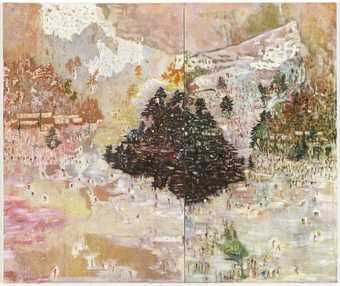
Peter Doig
Ski Jacket (1994)
Tate
Often working from photographs and films, Doig uses a broad range of subjects, exploring the general theme of man’s relation with his environment. The surfaces of his paintings, especially those from the early 1990s, appear complex and tangled, offering frustrated, interrupted views. Concrete Cabin West Side (1994) shows a typically luminescent view through dark trees of Le Corbusier’s Unité d’Habitation at Briey-en-Forêt in France, shrouding this monument to Modernist idealism in pagan mystery. The influence of the Canadian landscape, as well as of Doig’s own leisure interests, can be seen in the painting Ski Jacket (1994; London, Tate), a view of a busy ski resort. Acid colours and a loose technique suggest comparisons with Post-Impressionists such as Bonnard, while the attention paid to contemporary leisure space can be compared with the work of the German photographer Andreas Gursky. His use and exploration of popular culture can be seen in the paintings Buffalo Station I and Buffalo Station II (both 1997–8), mirrored views of people emerging from a stadium in Buffalo, NY, after a 1997 Rolling Stones concert.
